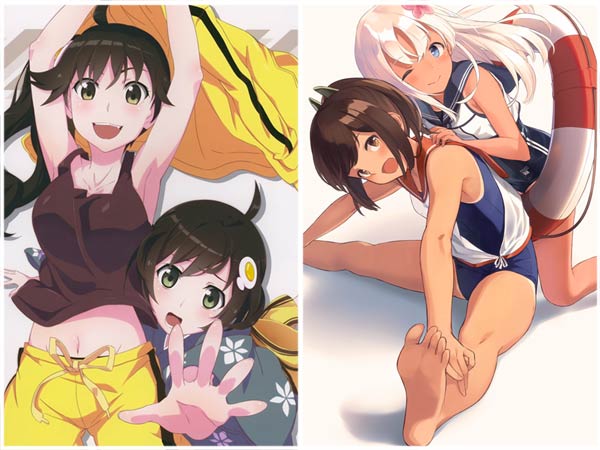Hello from sunny Phoenix, Arizona, where we’ve come for the Phoenix Comicon. It’s a balmy 114℉/46℃, and we’re busy at the show, selling tons of fun products from Japan. Hope to see you here!
I like exploring the sources of various memes that exist in anime, like the time I researched the origin or the imouto (younger sister) fascination in pop culture, which turned out to be a 1983 anime called Miyuki about a love triangle between a boy, his girlfriend and his not-related-by-blood younger sister, the latter two both being named Miyuki. One day I was wondering about the history behind Japan’s rather unique school swimsuits, called sukuuru mizugi or just sukumizu in the trades. Starting around 1955, Japan was modernizing its educational system and requiring that pools be installed to teach swimming as a required course, with officially designated school swimsuits made from the newly-available material nylon. Schools soon standardized on “skirt type” swimsuits, with a separating line across the abdomen looking somewhat like a skirt, but around 1985 these started being replaced by the sleeker “competition” style swimsuit. Riding the coat-tails of maid uniforms and shimapan, school swimsuits became an icon of Japanese moe culture thanks in part Strike Witches, which introduced the sukumiku-as-military-uniform concept. If you’re interested in obtaining one of these school swimsuits for cosplay or other uses, we just happen to have them in stock, in female and otokonoko versions.
If you’re going to travel to Japan, you’d better bring your suitscase, and make sure you wear a clean shirts and a nice suits. My favorite sports is soccer, and my favorite anime show is Fruits Basket. Sound odd? Due to a quirky reason of phonetics, some English words are imported into Japanese in their plural forms. The word for a swimsuit in Japanese is “swimsuits,” even though you may only be talking about one, and a can of fruit juice is always “fruits juice.” Japanese don’t mind these words, although the misuse of English grammar tends to give English natives the heebie jeebies at first. Sometimes the words are used in their plural forms to make them easier for Japanese to pronounce or write, and other times because to keep two words from sounding the same and causing confusion. (Because “fruit” and “flute” would have the same pronunciation phonetically, “fruits” becomes the word for the stuff you eat.)

We’re at the Phoenix Comicon, one of our favorite conventions, with lots of great anime products for everyone. If you’ll be at the show, be sure to swing by booth 635 and check out what we’ve brought! Make sure you come to our eroge and visual novel panel on Friday at 10 pm!
















